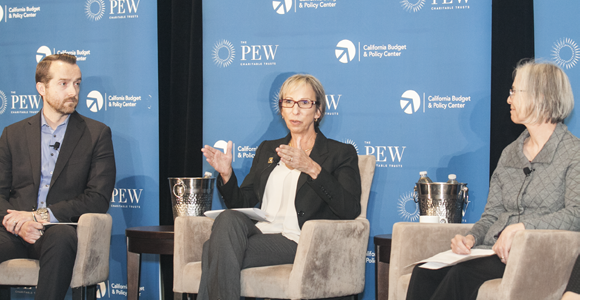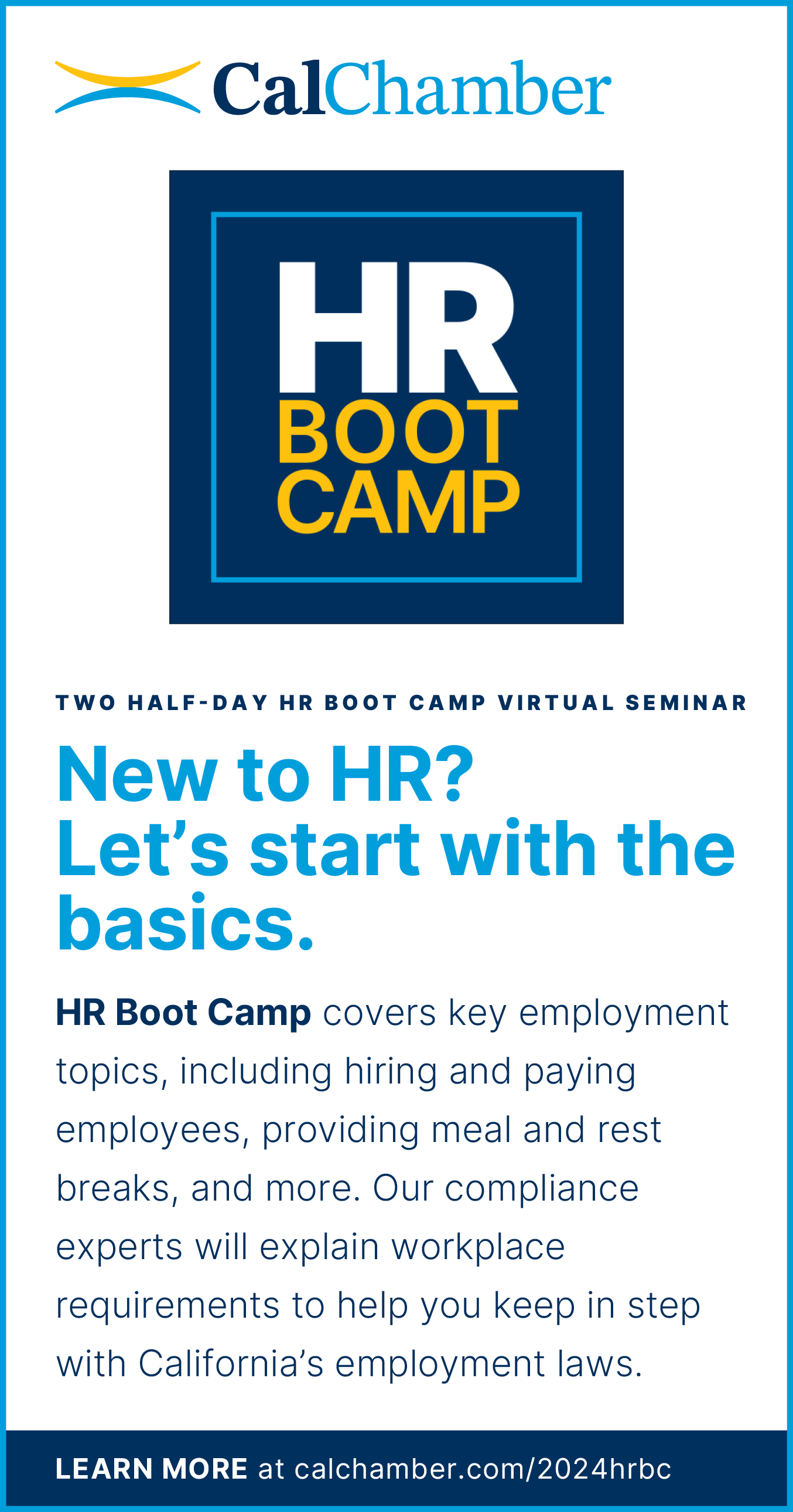
Numerous questions remain about how the new state-run retirement savings program will be implemented, but it is critical that everyone be educated about their roles to make the program successful, said California Chamber of Commerce Policy Advocate Marti Fisher during a panel discussion in Sacramento on November 17.
The discussion about what the California Secure Choice Retirement Savings Investment Program means for employers was part of an expert convening hosted by The Pew Charitable Trusts and the California Budget & Policy Center.
Joining Fisher on the panel moderated by KQED reporter Marisa Lagos were Nancy Berlin, policy director of the California Association of Nonprofits, and Mark Herbert, California director of Small Business Majority.
Signed by Governor Edmund G. Brown Jr. this year, SB 1234 (de León; D-Los Angeles; Chapter 804), along with the original 2012 legislation, SB 1234 (de León; D-Los Angeles; Chapter 734) and SB 923 (de León; D-Los Angeles; Chapter 737), creates a framework for the California Secure Choice Retirement Savings Investment Program.
The program will not begin enrolling participants until regulations have been developed, a process that is not expected to be completed for about two years.

Program Under Development
The Secure Choice program is a state-run retirement savings plan mandated for private employees that includes automatic enrollment with an opt-out provision for an estimated 6.3 million California workers whose employers do not currently offer an eligible retirement savings program.
Private employers with five or more employees will be required to automatically enroll their employees in and make payroll deductions for the Secure Choice retirement accounts, unless the employee opts out. Employers that do not offer a retirement plan or auto-enroll their employees in Secure Choice would be subject to a penalty; otherwise the program is intended to impose no risk or liability to the employer or to the state. It is intended that employers’ responsibility is simply a pass-through—to deduct and submit contributions from employee wages.
“Everyone has to understand their roles and responsibilities, especially the employers, who need to understand what they can and can’t do,” said Fisher. “Although the program is designed to simply be a pass-through of the money, there are so many issues and questions around that. Therefore, we really need to do a good job educating everyone about how this is going to operate, and the sooner and the earlier, the better.”
The program will be funded by an automatic 3% to 5% payroll deduction; the specific default contribution will be determined by the Secure Choice Investment Board. The employer makes no contribution into the retirement account. The 2016–2017 state budget authorized $1.9 million to the program for start-up costs. As projected by the feasibility study completed in 2016, the estimated cost to fully fund the program and its infrastructure will be $134 million.
Once Secure Choice opens its doors—in about two years—it will be phased in: eligible employers with more than 100 employees will be mandated to enroll employees within 12 months after the program is open for enrollment; employers with more than 50 employees will be mandated to participate within 24 months after the program is open for enrollment; and within 36 months, all other eligible employers will be required to participate.
Business Expresses Concerns
During the legislative progress of SB 1234 in 2012 and in 2016, a large coalition of employer organizations across many industries expressed significant concerns with the proposed plan. Although CalChamber and the coalition ultimately removed opposition, they did so because concerns regarding employer liability were addressed to the extent possible and as proposed by the coalition.
To address employer concerns regarding liability and administrative burdens for employers, the author agreed to coalition-proposed amendments to SB 1234, which establishes the Secure Choice Retirement Savings Program:
• Clarifying Applicability of Federal Law. A concern of employers from the beginning was that if the program was found to be subject to the federal Employee Retirement Income Security Act of 1974 (ERISA), employers could be subject to significant liability, and the entire program could be at risk. Final language in the bill states that the program will not be implemented until the program board reports to the Legislature that the program conforms to federal Department of Labor criteria for the safe harbor under ERISA, and the Individual Retirement Account (IRA) arrangements offered by the Secure Choice program qualify for the same favorable income tax treatment as other IRAs.
• Limiting Employer Liability. Amendments clarified the intent of the Legislature that the employer is not a sponsor of the retirement plan if the program is subsequently found to be pre-empted by any federal law or regulation.
• Enhancing Disclosure to Employees. SB 1234 requires the Employment Development Department to develop a disclosure packet to be provided to each employee along with a form for employees to acknowledge they received the packet. Additional language proposed by the CalChamber and coalition reiterated that the retirement plan is not sponsored by the employer, so the employer is not responsible for the plan or liable as a plan sponsor, and that the employer does not provide financial advice.
• Establishing Operational Model that Shields Employers from Misplaced Liability and Administrative Burden. As suggested by the CalChamber and coalition, the plan will have a third-party administrator that limits employer interaction and transactions with the employee.
The primary concern is the potential employer exposure to liability, especially in regards to the potential applicability to or pre-emption of the program by ERISA. If ERISA were to apply, employers could be at risk for considerable liability, which is unknown because this type of program has never been done before. The coalition attempted to minimize this risk to the extent possible with proposed amendments which the author accepted and incorporated into the legislation.
Secure Choice enrollment will not begin until certain requirements are met. It is anticipated that enrollment will begin in 2019 or later.
CalChamber Position
The Secure Choice program must comply with the principles embodied in state law and U.S. Department of Labor rules, Fisher explained.
“The regulations must create program guidelines and rules that are fair and maintain the limited liability and limited administrative participation for employers. In addition, the program must be easy for employees and employers to understand, easy to implement and easy to comply with its requirements,” she said
It is critical, Fisher stressed, that education and outreach take place in a comprehensive manner in advance of the program, and that adequate resources are accessible before enrollment and into the future, and known to employers so they can seek assistance in implementing the program. It also is critical that employers provide input to the rulemaking as significant operational decisions that affect employers will be made though new regulations.
The rulemaking process must be transparent and include adequate and real employer participation to address employer concerns and their operations that will be affected.
It is estimated that more than 6 million employees will be eligible for Secure Choice. That is an enormous number of individuals to educate and enroll; equally huge is the corresponding education and support needed for employers to ensure an orderly, smooth enrollment process, and avoidance of liability and risk for employers.
Employers must be educated regarding their responsibility for withholding and directing contributions, and for opting employees in and out. Administrative provisions must be established and effectively communicated to both employees and employers.
Fisher said CalChamber will continue to actively engage in rulemaking, closely monitor Secure Choice Investment Board activities, and provide input as appropriate about program design and employer risk.



